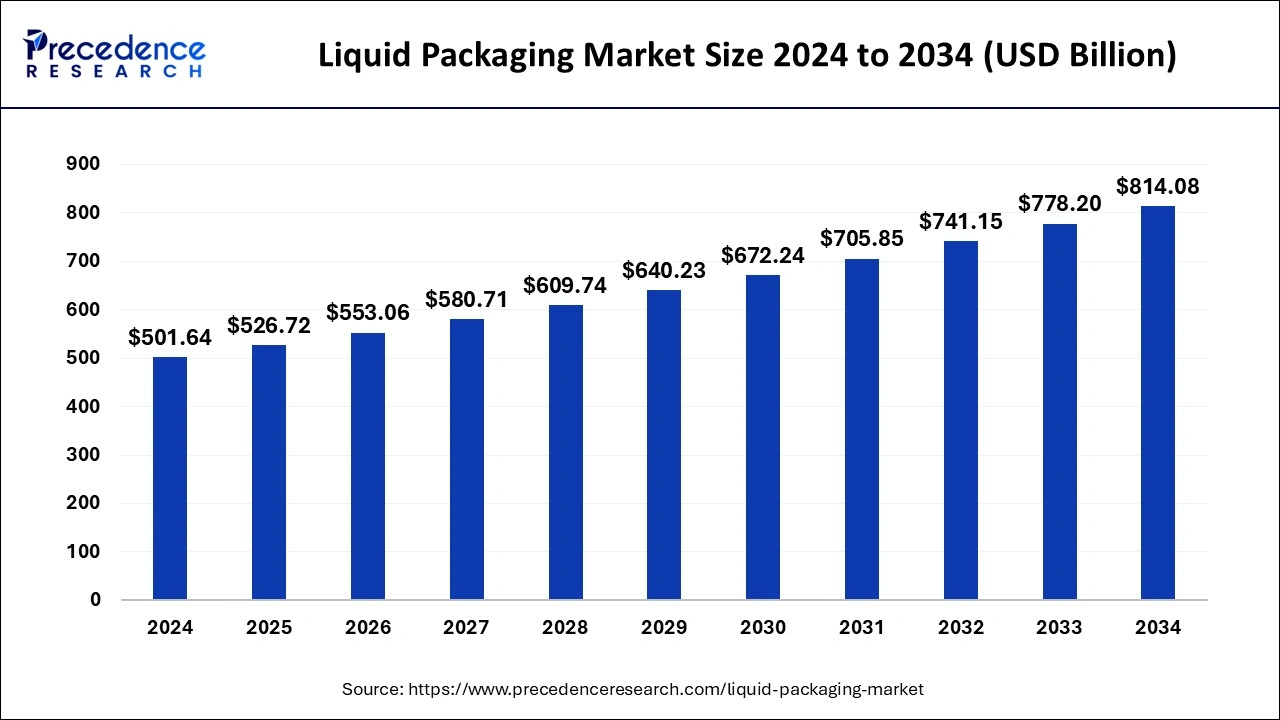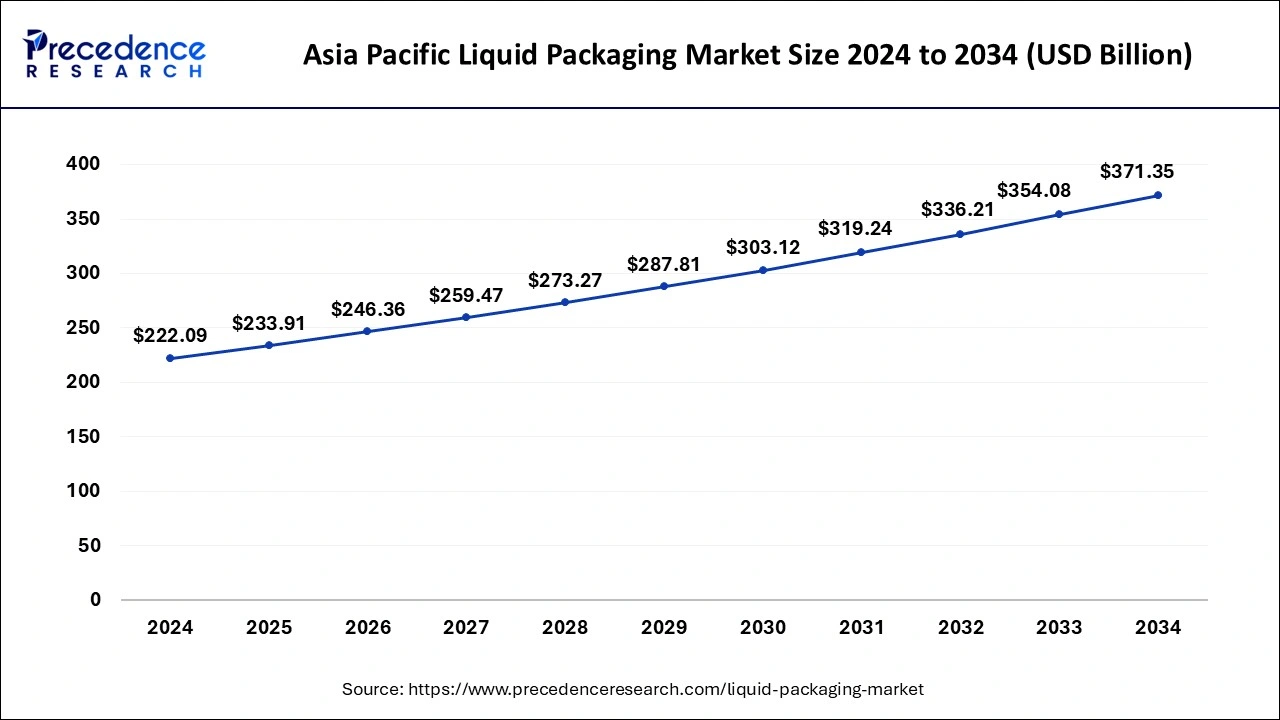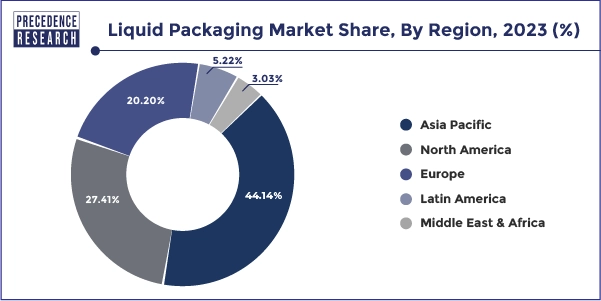List of Contents
Liquid Packaging Market Size and Forecast 2025 to 2034
The global liquid packaging market size accounted for USD 501.64 billion in 2024 and is expected to reach around USD 814.08 billion by 2034, expanding at a CAGR of 4.96% from 2025 to 2034.

Liquid Packaging Market Key Takeaways
- Asia-Pacific region contributed 44% revenue share in 2024.
- North America market is expected to grow at a CAGR of 5.7% from 2025 to 2034.
- By materials, the plastics segment accounted for the largest revenue share of around 41% in 2024.
- By technology, the aseptic liquid packaging segment accounted for 76% revenue share in 2024.
- By packaging type, the rigid segment has garnered 85.5% market share in 2024.
Asia Pacific Liquid Packaging Market Size and Growth 2025 to 2034
The Asia Pacific liquid packaging market size was estimated at USD 222.09 billion in 2024 and is predicted to be worth around USD 371.35 billion by 2034 with a CAGR of 5.27% from 2025 to 2034.

In terms of region, the Asia Pacific exhibits the highest demand for liquid packaging and accounted for around 44% value share in the year 2024. This is primarily because of the favorable government policies for manufacturers, expansion in pharmaceutical and food & beverage sectors, and the shifting of the production facilities in the region due to low operating and labor costs.

Besides this, North America expected to grow at a moderate rate over the forecast period. The U.S. is considered as the leading contributor towards the growth of the region because of prominent demand for liquid packaging along with rising implementation of paper products over other harmful materials in the region expected to propel the demand for liquid packaging in North America in the coming years.
Liquid Packaging Market Growth Factors
Glass, paper & paper boards, metals (tinplate, foils & laminates, aluminum, & tin-free steel), and plastics are the materials that have traditionally been uses in the food packaging. Further, emergence of aluminum films for packaging application expected to upend thefood packaging industryand further propels the growth of liquid packaging market over the upcoming years. In addition, rising trend towards freshness and quality of the food in the duration of storage and distribution expected to impel the market growth for liquid packaging.
Furthermore, increasing application of plastics forbeverage packagingbecause of its low cost compared to other materials such as glass and tin-plates likely to prosper the growth of the market. Plastics offer some functional advantages over other packaging materials that include microwavability, thermo-sealability, unlimited sizes & shapes, and optical properties is the other prime factors that boosts the growth of the liquid packaging. Use of plastic material separates the contact of product from environment that protects it from moisture and bacteria, thereby increasing its shelf life.
In addition, large number of people shifting towards urban areas expected to propel the growth of liquid packaging in for supporting transportation of liquid products over long distance along with increasing their shelf life. Attraction towards lifestyle coupled with greater opportunity for income in the urban areas draws large number of population towards cities.
Market Scope
| Report Highlights | Details |
| Market Size in 2025 | USD 526.72 Billion |
| Market Size by 2034 | USD 814.08 Billion |
| Growth Rate from 2024 to 2034 | CAGR of 4.96% |
| Largest Market | Asia Pacific |
| Base Year | 2024 |
| Forecast Period | 2025 to 2034 |
| Segments Covered | Packaging Type, Raw Material, Technique, End-use, and Region |
| Regional Scope | North America, APAC, Europe, Latin America, MEAN, Rest of the World |
Packaging Type Insights
In terms of value, rigid packaging emerged as a dominant segment, accounting for the major market share of over 85.5% in 2023. Rigid packaging is extensively used to manufacture the packaging solutions for pharmaceutical drugs and beverages. This is mainly because of the exceptional properties of rigid packaging over other packaging type that includes excellent shelf-life and ease of transport & carrying.
On the other side, increasing application of flexible packaging materials owing to light weight, low transportation cost, and flexibility in the size & shape of the package anticipated to boost the growth of flexible packaging solutions over the upcoming years.
Raw Material Insights
In terms of raw material, plastics led the global liquid packaging market and accounted for more than half of the value share in the year 2023. Plastics are the most preferred material in the manufacturing of packaging solutions for different end-use verticals such as pharmaceutical, food & beverage, household care, and personal care.
However, paper segment likely to exhibit significant growth over the coming years owing to its excellent properties that include better environmental protection and high recyclability. A further, stringent government norm on restricting the usage of non-degradable plastics is the other major factors that impel the demand for paper materials. Suppliers of paper packaging solutions such as paperboard containers and boxes have increased their production capacities in response to meet the dynamic market conditions.
Key Companies & Market Share Insights
The global liquid packaging market seeks intense competition among the market players because of rapid changes in the consumer preference that drive large number of innovation and product development. Further, the brand managers are largely focused towards grabbing maximum market share on the global scale on account of product differentiation and customization. For instance, in March 2020, Smurfit Kappa's new Top Clip solution was launched by a beer brewer Royal Grolsch as a paper-based material replacement for the plastic shrink wrap that are currently used on their can multi-packs.
Liquid Packaging MarketCompanies
- Comar LLC
- Tetra Laval International S.A.
- Liqui-Box Corporation
- Evergreen Packaging Inc.
- International Paper Company
- BillerudKorsnäs AB
- Nippon Paper Industries Co., Ltd.
- Klabin Paper
- The DOW Chemical Company
- Smurfit Kappa Group
- Mondi PLC.
Segments Covered in the Report
By Packaging Type
- Flexible
- Sachets
- Films
- Pouches
- Rigid
- Bottles
- Paperboard
- Drums
- Cans
- Containers
By Raw Material
- Paper
- Plastics
- PP
- PET
- PE
- Glass
- Metal
By Technique
- Modified Atmosphere Packaging
- Aseptic Packaging
- Intelligent Packaging
- Vacuum Packaging
By End-use
- Personal Care
- Food & Beverage
- Chemicals
- Pharmaceuticals
- Petrochemicals
- Household Care
By Regional Outlook
- North America
- U.S.
- Canada
- Europe
- U.K.
- Germany
- France
- Asia Pacific
- China
- India
- Japan
- South Korea
- Rest of the World
For inquiries regarding discounts, bulk purchases, or customization requests, please contact us at sales@precedenceresearch.com
Frequently Asked Questions
Ask For Sample
No cookie-cutter, only authentic analysis – take the 1st step to become a Precedence Research client